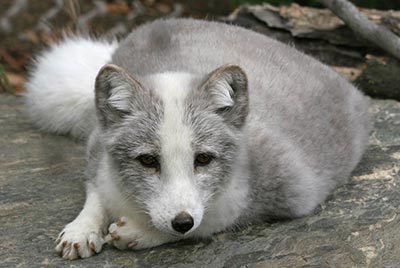| Quick Facts | |
|---|---|
| Name Meaning: | Master of the Grasses |
| Length: | 4.5 ft. |
| Weight | 150 lbs. |
| Region: | South America |
| Habitat: | Wetlands |
| Diet: | Herbivore |
| Conservation Status: | Least Concern (LC) |
| Linnaean Classification | |
| Kingdom: | Animalia |
| Phylum: | Chordata |
| Subphylum: | Vertebrata |
| Class: | Mammalia |
| Order: | Carnivora |
| Family: | Canidae |
| Genus: | Alopex |
| Species: | Alopex lagopus |
Artic Fox
The Arctic Fox is a small animal approximately the size of a large cat. Generally it ranges in color from pure white to a brownish-blue color. Its legs are short as are its ears. This shortness in its extremities allows it to preserve body heat in cold climates. In addition to a high concentration of body fat it has very thick fur which is warmer than that of any other mammal including the polar bear. It even has fur on the underside of their paws to keep it warm and to avoid sliding on icy surfaces. In addition to this it also has countercurrent heat exchange in the paws to help maintain an even body temperature.
History
The Arctic Fox also has Greek and Latin names. The Greek name Alopex lagopus means "fox," while the Latin name Vulpes lagopus means "hair on feet," Referring to the hair found on its paw pads. While a number of subspecies are endangered from one threat or another, the majority of the species remain numerous due to a high breeding rate. However, their population has in recent years been somewhat overtaken by that of the Red Fox. The Arctic Fox is also the only native mammal in Iceland.Lifestyle
The Arctic Fox lives in some of the coldest areas on the planet. It has been able to cope with this due to its thick fur, body fat, and unique circulation system. Its hearing is so good that it can target prey under snow. The fur changes color depending on the season, white in winter to blend in with the environment and brown during the summer. Around 5-10 pups can be born in a single litter and sometimes more. The families are close, often sticking together even after the cubs have reached adulthood. To eat, the Arctic Fox will eat meat of any kind available. This includes Lemmings, Hares, Seals, and Fish. It will also often scavenge for leftovers of other predators like the polar bear.
ScienceViews Writer: Jason Hamilton.
Copyright © 2005-2010 Calvin & Rosanna Hamilton. All rights reserved.
